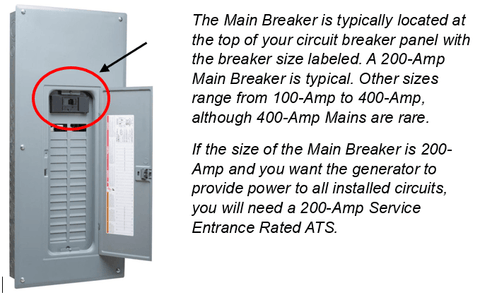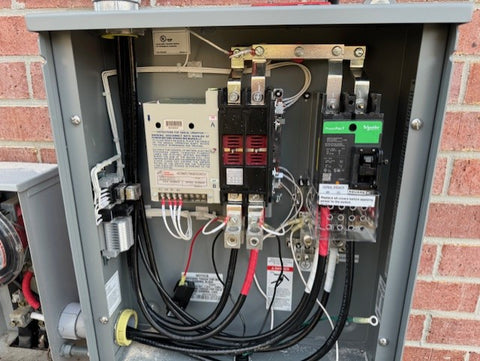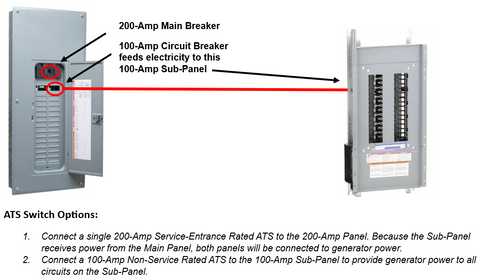Complete Homeowner's Guide to Generator Transfer Switches
What is a Transfer Switch and Why Do You Need One?
A transfer switch is the heart of your backup power system. Think of it as the "brain" that safely connects your home's electrical system to your generator when the power goes out, and switches back to utility power when it's restored.
The bottom line: If you're getting a standby generator, you need a transfer switch. It's required by electrical codes and ensures your family's safety.
Manual vs. Automatic Transfer Switches
Manual Transfer Switches
- Best for: Portable generators
- How it works: You manually flip the switch after starting your portable generator
- Cost: Less expensive upfront
- Convenience: You have to be home and remember to switch it "on"
Automatic Transfer Switches (ATS)
- Best for: Permanent standby generators
- How it works: Monitors incoming utility power and detects power outages. Starts your generator within seconds
- Cost: Higher upfront investment
- Convenience: Works even when you're not home - complete peace of mind
Our recommendation: If you're investing in a standby generator, go with an automatic transfer switch. The convenience and reliability are worth every penny.
What Size Transfer Switch Do You Need?
This is simpler than you might think. Here's how to figure it out in 3 easy steps:
Step 1: Find Your Main Breaker Panel
Go to your electrical panel (usually in your garage, basement, or utility room). Look for the largest breaker at the top - this is your main breaker.
Step 2: Check the Amperage
The main breaker will have a number on it like 100, 200, or 400. This is your service size in amps.
Step 3: Match Your Transfer Switch
Your transfer switch should match your main breaker size:
- 200-amp main breaker = 200-amp transfer switch
- 100-amp main breaker = 100-amp transfer switch
- And so on...

Service Entrance vs. Non-Service Entrance: What's the Difference?
Service Entrance Rated Transfer Switch
- Use when: Connecting directly to your main electrical panel
- Identifies as: Has its own main breaker built-in
- Best for: Whole house backup power
- Most common sizes: 100-amp, 200-amp, 400-amp
Non-Service Entrance Rated Transfer Switch
- Use when: Connecting to a sub-panel (a smaller panel fed from your main panel)
- Identifies as: No main breaker on the transfer switch itself
- Best for: Powering essential circuits only, such as circuits on a sub-panel
- Common sizes: 100-amp, 200-amp

How Much of Your House Do You Want to Power?
Whole House Coverage
What you get: Everything in your home runs normally during an outage
What you need: Service entrance rated transfer switch matching each of your main panels
Best for: Families who want zero lifestyle changes during outages
Essential Circuits Only
What you get: Lights, refrigerator, furnace, some outlets, and other necessities
What you need: Smaller transfer switch connected to essential circuits
Best for: Budget-conscious homeowners who want basic comfort and safety
Buckeye Power Systems recommends the Cummins RA Series Switches which are compatible with Cummins RS (ex. RS20A air-cooled or RS30 liquid-cooled, and RX Series (ex. RX30, etc.) generators.
Popular Transfer Switch Options
For Whole House Coverage
- 200-Amp Service Entrance Rated: Perfect for most homes with single main panel
- 400-Amp Service Entrance Rated: For larger homes or when you want one switch instead of two 200-amp switches
Below is an image of a typical RA Series Automatic Transfer switch. Available sizes include 100-Amp, 200-Amp, and 400-Amp. Be sure to match the size of the switch to the size of the Main Breaker if selecting a service-entrance rated switch.

Links to RA Series switches, each suitable for outdoor mounted installations:
RA100 100-Amp Non-Service Rated ATS
RA100SE 100-Amp Service Entrance Rated ATS
RA200 200-Amp Non-Service Rated ATS
RA200SE 200-Amp Service Entrance Rated ATS
RA400SE 400-Amp Service Entrance Rated ATS
For Essential Circuits
- 100-Amp Integrated Load Center: Indoor installation, includes 20 circuit breaker spaces. Instead of installing a sub-panel and an ATS, this integrated load center solution combines the features and benefits of each.
- 100-Amp or 200-Amp Non-Service Rated: Connects to existing sub-panels
Cummins also has an integrated 100-Amp switch suitable for partial-house generator coverage.

The integrated load center / switch includes 20 spaces for circuit breakers you wish the generator to power during an outage. These circuit breakers are often tied to circuits on one or more Main Breaker panels. The generator will only power electrical circuits installed on the integrated switch.
Note: This load center/ATS is only suitable for indoor installations.
Cummins 100-Amp Integrated Load Center/ATS - Non-Service Rated
Money-Saving Tips
- Two 200-amp switches cost less than one 400-amp switch - choose based on your installation space
- Consider essential circuits coverage first - you can always upgrade later
- Plan your installation location carefully - outdoor-rated switches offer more flexibility

Is Your Home Single-Phase or Three-Phase?
Simple test: Look at your electric bill. If you get one electric bill, you have single-phase service (like 99% of homes). All the switches we've discussed work with single-phase service.
Three-phase service is rare in homes and typically only powers air conditioning loads or special equipment. If you're unsure, your electrician can confirm this quickly.
Quick Decision Guide
Answer these questions:
-
Do you want whole house coverage or just essentials?
- Whole house → Service entrance rated switch
- Essentials only → Non-service rated switch or integrated load center
-
What's your main breaker size?
- Match your transfer switch size to this number
-
How many main panels do you have?
- One panel → One transfer switch
- Multiple panels → One switch per panel or one larger switch
-
Indoor or outdoor installation?
- Most switches work outdoors; integrated load centers are indoor-only
Next Steps
Once you've identified the right transfer switch size and type:
- Consult with a licensed electrician for proper installation
- Check local electrical codes - requirements vary by location
- Consider professional sizing - an expert can verify your calculations
- Plan your generator placement - this affects installation costs
Remember, a transfer switch is a long-term investment in your family's comfort and safety. Choose quality components and professional installation for the best results.
Questions about transfer switches? Don't hesitate to call a Buckeye Power Systems generator expert who can walk you through your specific situation and local requirements.
